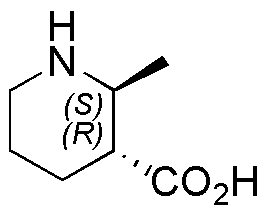(2S,3R)-2-Methyl-piperidine-3-carboxylic acid is widely utilized in research focused on:
- Pharmaceutical Development: This compound serves as a key intermediate in the synthesis of various pharmaceuticals, particularly in the development of drugs targeting neurological disorders.
- Organic Synthesis: It is employed in the production of complex organic molecules, enhancing the efficiency of chemical reactions due to its unique structural properties.
- Biochemical Research: Researchers use it to study enzyme activity and protein interactions, providing insights into metabolic pathways and potential therapeutic targets.
- Material Science: The compound is explored for its potential in creating novel materials, including polymers and coatings, that require specific functional properties.
- Agricultural Chemistry: It is investigated for use in developing agrochemicals, contributing to more effective pest control solutions with reduced environmental impact.
General Information
Properties
Safety and Regulations
Applications
(2S,3R)-2-Methyl-piperidine-3-carboxylic acid is widely utilized in research focused on:
- Pharmaceutical Development: This compound serves as a key intermediate in the synthesis of various pharmaceuticals, particularly in the development of drugs targeting neurological disorders.
- Organic Synthesis: It is employed in the production of complex organic molecules, enhancing the efficiency of chemical reactions due to its unique structural properties.
- Biochemical Research: Researchers use it to study enzyme activity and protein interactions, providing insights into metabolic pathways and potential therapeutic targets.
- Material Science: The compound is explored for its potential in creating novel materials, including polymers and coatings, that require specific functional properties.
- Agricultural Chemistry: It is investigated for use in developing agrochemicals, contributing to more effective pest control solutions with reduced environmental impact.
Documents
Safety Data Sheets (SDS)
The SDS provides comprehensive safety information on handling, storage, and disposal of the product.
Product Specification (PS)
The PS provides a comprehensive breakdown of the product’s properties, including chemical composition, physical state, purity, and storage requirements. It also details acceptable quality ranges and the product's intended applications.
Certificates of Analysis (COA)
Search for Certificates of Analysis (COA) by entering the products Lot Number. Lot and Batch Numbers can be found on a product’s label following the words ‘Lot’ or ‘Batch’.
*Catalog Number
*Lot Number
Certificates Of Origin (COO)
This COO confirms the country where the product was manufactured, and also details the materials and components used in it and whether it is derived from natural, synthetic, or other specific sources. This certificate may be required for customs, trade, and regulatory compliance.
*Catalog Number
*Lot Number
Safety Data Sheets (SDS)
The SDS provides comprehensive safety information on handling, storage, and disposal of the product.
DownloadProduct Specification (PS)
The PS provides a comprehensive breakdown of the product’s properties, including chemical composition, physical state, purity, and storage requirements. It also details acceptable quality ranges and the product's intended applications.
DownloadCertificates of Analysis (COA)
Search for Certificates of Analysis (COA) by entering the products Lot Number. Lot and Batch Numbers can be found on a product’s label following the words ‘Lot’ or ‘Batch’.
*Catalog Number
*Lot Number
Certificates Of Origin (COO)
This COO confirms the country where the product was manufactured, and also details the materials and components used in it and whether it is derived from natural, synthetic, or other specific sources. This certificate may be required for customs, trade, and regulatory compliance.


